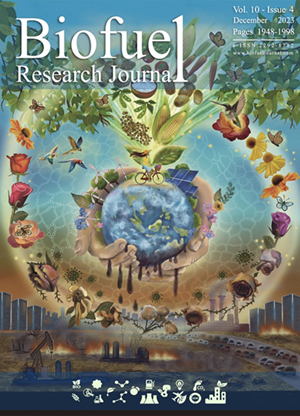Towards nationwide implementation of 40% biodiesel blend fuel in Indonesia: a comprehensive road test and laboratory evaluation
IF 11.9
Q1 ENERGY & FUELS
引用次数: 1
Abstract
This research focused on evaluating the technical viability of using biodiesel with a blending ratio of 40% v/v, which is expected to be implemented soon in Indonesia. Two kinds of biodiesel blends were prepared, a blend of 60% diesel fuel and 40% biodiesel (B40) and a blend of 60% diesel fuel, 30% biodiesel, and 10% hydrogenated vegetable oil (HVO) (B30D10). The fuels were tested on EuroII vehicles without any engine modifications through a 50,000 km endurance road test. Laboratory tests were also performed at certain traveled distances to evaluate various engine parameters, including power, fuel economy, exhaust emissions, and used engine oil properties. Engine components were inspected upon the completion of the road test. Cold-start ability was also examined to confirm the suitability of the investigated biofuels at low-temperature operating conditions in Indonesia. The road test results showed that vehicles fuelled with B40 and B30D10 could reach a distance of 50,000 km without encountering any technical issues. The laboratory evaluation during the road test indicated that B30D10 had a higher power and fuel economy than B40, with a maximum difference of 2%. Furthermore, B30D10 emitted lower CO, HC, and PM emissions than B40 throughout the distance traveled, with maximum differences of 11.4%, 14.7%, and 22.6%, respectively, but led to 15% higher NOx. Engine component inspection and used engine oil analysis confirmed the fulfillment of the manufacturer's recommendations for both B40 and B30D10. Finally, B40 and B30D10 were suitable for operating at low ambient temperatures in Indonesia, confirming them as practical options to be implemented in the nationwide 40% biodiesel blend fuel.在印度尼西亚实现40%生物柴油混合燃料的全国实施:全面的道路试验和实验室评估
这项研究的重点是评估使用混合比为40%v/v的生物柴油的技术可行性,预计该技术将很快在印度尼西亚实施。制备了两种生物柴油混合物,即60%柴油和40%生物柴油的混合物(B40),以及60%柴油、30%生物柴油和10%氢化植物油的混合物(B30D10)。这些燃料在没有任何发动机改装的EuroII车辆上进行了50000公里的耐久性道路测试。实验室测试也在一定的行驶距离进行,以评估各种发动机参数,包括功率、燃油经济性、废气排放和使用过的发动机机油特性。路试结束后,对发动机部件进行了检查。还检查了冷启动能力,以确认所研究的生物燃料在印度尼西亚低温操作条件下的适用性。道路测试结果表明,使用B40和B30D10的车辆可以行驶50000公里,而不会遇到任何技术问题。路试期间的实验室评估表明,B30D10比B40具有更高的动力和燃油经济性,最大差异为2%。此外,B30D10在整个行驶距离内排放的CO、HC和PM低于B40,最大差异分别为11.4%、14.7%和22.6%,但导致NOx增加15%。发动机部件检查和使用过的发动机机油分析证实了制造商对B40和B30D10的建议得到了满足。最后,B40和B30D10适合在印度尼西亚的低环境温度下运行,这证实了它们是在全国40%的生物柴油混合燃料中实施的实用选择。
本文章由计算机程序翻译,如有差异,请以英文原文为准。
求助全文
约1分钟内获得全文
求助全文
来源期刊

Biofuel Research Journal-BRJ
ENERGY & FUELS-
CiteScore
22.10
自引率
1.50%
发文量
15
审稿时长
8 weeks
期刊介绍:
Biofuel Research Journal (BRJ) is a leading, peer-reviewed academic journal that focuses on high-quality research in the field of biofuels, bioproducts, and biomass-derived materials and technologies. The journal's primary goal is to contribute to the advancement of knowledge and understanding in the areas of sustainable energy solutions, environmental protection, and the circular economy. BRJ accepts various types of articles, including original research papers, review papers, case studies, short communications, and hypotheses. The specific areas covered by the journal include Biofuels and Bioproducts, Biomass Valorization, Biomass-Derived Materials for Energy and Storage Systems, Techno-Economic and Environmental Assessments, Climate Change and Sustainability, and Biofuels and Bioproducts in Circular Economy, among others. BRJ actively encourages interdisciplinary collaborations among researchers, engineers, scientists, policymakers, and industry experts to facilitate the adoption of sustainable energy solutions and promote a greener future. The journal maintains rigorous standards of peer review and editorial integrity to ensure that only impactful and high-quality research is published. Currently, BRJ is indexed by several prominent databases such as Web of Science, CAS Databases, Directory of Open Access Journals, Scimago Journal Rank, Scopus, Google Scholar, Elektronische Zeitschriftenbibliothek EZB, et al.
 求助内容:
求助内容: 应助结果提醒方式:
应助结果提醒方式:


